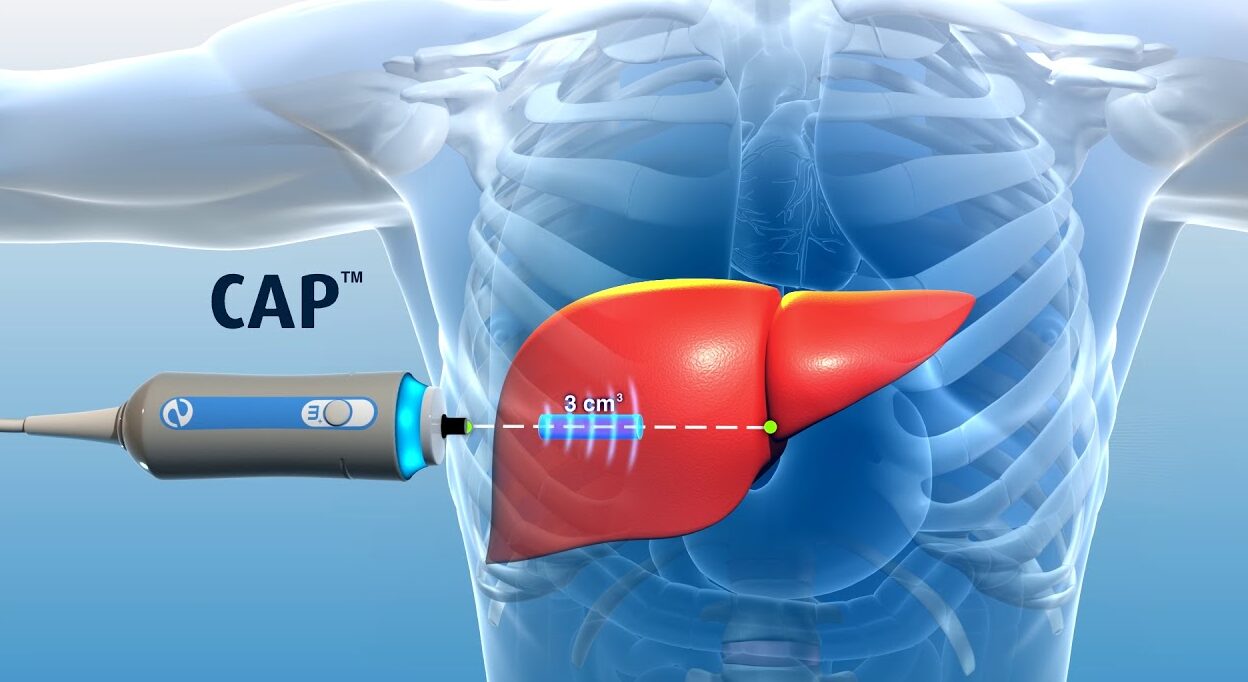Technology
Decoding the Results: Interpreting FibroScan Scores for Accurate Liver Disease Diagnosis

Unlocking the mysteries of liver health has always been a challenge for medical professionals. But thanks to advancements in technology, we now have a powerful tool at our disposal: FibroScan Scores . This groundbreaking noninvasive procedure allows us to assess liver stiffness and fibrosis with remarkable accuracy. However, understanding the results can be quite overwhelming for patients. That’s why we’re here to help decode those numbers and provide you with a clear understanding of what they mean for your liver health. So, let’s dive into the world of FibroScan scores and unravel the secrets hidden within!
Understanding Your Liver Elastography (FibroScan) Results
When it comes to assessing liver health, FibroScan is the name you need to know. This innovative technology uses elastography to measure liver stiffness and fibrosis, providing crucial insights into your liver’s condition. But what do these results actually mean?
First, let’s talk about liver stiffness. The FibroScan score ranges from 2.5 kPa (kilopascals) to 75 kPa – the higher the number, the stiffer your liver tissue is. A lower score indicates a healthier liver with minimal fibrosis or scarring.
Now onto fibrosis scoring. FibroScan Scores measures fibrosis on a scale of F0 to F4, with F0 representing no signs of fibrosis and F4 indicating severe cirrhosis. Understanding where you fall on this scale can give you a clearer picture of your liver’s overall health.
When reviewing your FibroScan Scores results, pay close attention to both the stiffness score and fibrosis stage. They provide valuable information that can guide further diagnostic steps and treatment plans tailored specifically for you.
Using Your Liver Stiffness Result to Find Your Fibrosis Score
When it comes to accurately diagnosing liver diseases, one important factor is understanding your liver stiffness result and how it relates to your fibrosis score. The liver stiffness measurement obtained through a FibroScan® test provides valuable information about the level of fibrosis or scarring in your liver.
The FibroScan device uses vibration-controlled transient elastography (VCTE) technology to measure the elasticity or stiffness of your liver. This noninvasive technique allows for quick and painless assessment of fibrosis without the need for a biopsy. Based on your liver stiffness result, which is measured in kilopascals (kPa), healthcare providers can determine the severity of fibrosis and assign a corresponding fibrosis score. Understanding this score can help guide treatment decisions and monitor disease progression over time.
Conditions That Can Affect Your Fibrosis Results
Your liver fibrosis results can be influenced by various factors that may affect the accuracy of your diagnosis. It’s important to understand these conditions and how they can impact the interpretation of your FibroScan scores.
One factor that can affect your fibrosis results is inflammation in the liver. Inflammatory conditions such as hepatitis B or C, alcoholic hepatitis, or autoimmune hepatitis can cause increased stiffness in the liver, leading to higher fibrosis scores. Additionally, if you have ongoing inflammation due to other health issues like obesity or metabolic syndrome, it can also contribute to elevated fibrosis scores. It’s crucial for healthcare providers to consider these underlying inflammatory conditions when interpreting FibroScan results for accurate diagnosis and treatment planning.
On the other hand, certain non-inflammatory conditions might lead to lower than expected fibrosis scores on your FibroScan report. For instance, if you have cholestasis (a condition where bile flow from the liver is impaired), it could result in decreased stiffness readings and falsely indicate a lower level of liver damage. Similarly, individuals with hepatic steatosis (accumulation of fat in the liver) may exhibit softer livers on elastography due to fat deposition masking actual fibrotic changes.
It’s essential for both patients and healthcare professionals alike to be aware of these various factors that can influence your FibroScan results accurately assess their significance when determining your overall liver health status.
Recommended Assessment Protocols for Liver Stiffness
When it comes to assessing liver stiffness, following recommended protocols is crucial for accurate results. These assessment protocols provide a standardized approach to measuring liver fibrosis using FibroScan® technology.
It is important to ensure that the patient has fasted for at least two hours prior to the examination. This allows for more reliable measurements of liver stiffness. Additionally, patients should be in a supine position with their right arm raised during the procedure.
During the examination, multiple measurements are taken and an average value is calculated. It’s important to note that each measurement should be performed at different sites on the liver. By adhering to these assessment protocols, healthcare professionals can obtain consistent and reliable data for diagnosing and monitoring liver disease progression accurately.
Noninvasive Techniques for Liver Steatosis Evaluation
When it comes to evaluating liver steatosis, noninvasive techniques have revolutionized the way doctors diagnose this condition. These methods provide a safe and efficient alternative to more invasive procedures. One such technique is FibroScan®, which uses ultrasound technology to measure liver stiffness and controlled attenuation parameter (CAP) score, providing valuable insights into the presence of fat in the liver.
The FibroScan® device works by emitting low-frequency waves that pass through the liver. By analyzing how these waves are reflected, healthcare professionals can assess the degree of fibrosis and determine if there is excess fat accumulation in the liver tissue. This noninvasive approach eliminates the need for a biopsy, reducing patient discomfort while still delivering accurate results. With advancements like FibroScan®, doctors can now confidently evaluate liver steatosis without resorting to invasive procedures.
Exploring Biomarkers in Monitoring Liver Allograft Function
Monitoring the function of a liver allograft is crucial for ensuring the success of a transplant. While traditional methods involve invasive procedures, there is growing interest in exploring noninvasive techniques such as biomarkers.
Biomarkers are biological substances that can indicate the presence or progression of a disease. In the context of monitoring liver allograft function, biomarkers provide valuable insights into graft health and rejection risk. By measuring specific molecules in blood or urine samples, healthcare professionals can assess inflammation levels, fibrosis progression, and even predict rejection episodes. This noninvasive approach not only reduces patient discomfort but also allows for more frequent monitoring to detect any changes early on.
By delving deeper into the use of biomarkers in monitoring liver allograft function, researchers aim to develop more accurate and reliable tools for assessing graft health. Continued exploration and research in this field hold great promise for improving post-transplant care and ultimately enhancing patient outcomes.
Role of FibroScan in Diagnosing Specific Liver Conditions
Liver diseases can manifest in various forms, making accurate diagnosis crucial for effective treatment. FibroScan has emerged as a valuable tool in diagnosing specific liver conditions. This noninvasive technique measures liver stiffness and provides insights into the presence of fibrosis or scarring.
FibroScan helps diagnose conditions such as hepatitis C, fatty liver disease, and alcoholic liver disease. It enables healthcare professionals to assess the severity of these conditions without the need for invasive procedures like biopsies. By accurately identifying the extent of fibrosis present, FibroScan allows doctors to develop personalized treatment plans tailored to each patient’s needs. The role of FibroScan in diagnosing specific liver conditions is truly revolutionary, providing both patients and healthcare providers with vital information for informed decision-making regarding their health.
Potential Applications of FibroScan in Polycystic Ovary Syndrome
Polycystic Ovary Syndrome (PCOS) is a complex hormonal disorder that affects women of reproductive age. It can lead to various health complications, including metabolic disorders and liver abnormalities. While the primary focus of FibroScan is liver assessment, recent research suggests its potential applications in evaluating liver fibrosis and steatosis in PCOS patients.
One study found a significant association between PCOS and increased liver stiffness measurements, indicating higher risk for liver fibrosis. Another study explored the use of FibroScan as a noninvasive tool to assess hepatic steatosis in women with PCOS. These findings are promising, suggesting that FibroScan could play an essential role in monitoring liver health among PCOS patients, aiding early detection and intervention to prevent further complications.
While more research is needed to fully understand the extent of FibroScan’s application in managing PCOS-related liver conditions, it holds great promise as a valuable diagnostic tool. By providing accurate and objective assessments without invasive procedures or radiation exposure, FibroScan may revolutionize how we approach liver evaluation in women with Polycystic Ovary Syndrome.
Featured Research on FibroScan and Liver Fibrogenesis
Researchers around the world have been studying the relationship between FibroScan and liver fibrogenesis, shedding light on this complex process. Exciting findings have emerged from these studies, providing valuable insights into the diagnostic capabilities of FibroScan.
One study conducted by a team of experts found that liver stiffness measured by FibroScan can accurately assess the stage of fibrosis in patients with chronic liver diseases. This noninvasive method has proven to be a reliable alternative to invasive biopsy procedures, allowing for more frequent monitoring of disease progression without causing unnecessary discomfort or complications for patients.
Another research project explored the role of inflammation in liver fibrogenesis. By utilizing advanced imaging techniques like elastography, researchers were able to identify specific markers associated with active inflammation and subsequent fibrosis development. These findings highlight the potential of FibroScan as a tool not only for diagnosing existing fibrosis but also for predicting future disease progression.
The field of research surrounding FibroScan and liver fibrogenesis is constantly evolving, offering hope for improved diagnosis and treatment options in the future. Stay tuned as scientists continue to unravel the complexities of this process through innovative studies using exciting technologies like FibroScan!
Stay Informed: Recommended Publications and Authors
When it comes to staying informed about the latest developments and research in liver disease diagnosis, having access to recommended publications and respected authors is crucial. These resources can provide valuable insights into the use of FibroScan® technology for accurate assessment. One publication worth exploring is “Liver International,” a leading journal that covers various aspects of hepatology, including noninvasive liver fibrosis assessment techniques like FibroScan®. Another noteworthy resource is “Hepatology Research,” which publishes studies on liver diseases and their management, showcasing advancements in diagnostic tools such as FibroScan®.
In addition to these publications, there are several renowned authors who have made significant contributions to the field of liver disease diagnosis. Dr. Laurent Castera, a key figure in elastography research and development, has published numerous articles on FibroScan®, highlighting its effectiveness as a noninvasive tool for assessing liver stiffness and fibrosis. Furthermore, researchers like Dr. Meng-Yao Lu have delved into topics such as transient elastography-based prediction models for advanced fibrosis detection using FibroScan®, providing further evidence of its clinical utility.
By keeping up with recommended publications and influential authors in the field of hepatology, you can stay informed about the latest findings regarding FibroScan® technology’s role in diagnosing liver conditions accurately. This knowledge will empower you to make well-informed decisions regarding your own health or that of your patients if you’re a healthcare professional working within this domain
Make an appointment for FibroScan
If you suspect that you may have liver disease or want to monitor your liver health, it is important to make an appointment for a FibroScan. This noninvasive procedure uses advanced technology to assess the stiffness of your liver and determine the presence and severity of fibrosis. By scheduling this simple scan, you can gain valuable insights into your liver health without the need for more invasive procedures.
During your appointment, a healthcare professional will use a specialized device to send vibrations through your skin and into your liver. The FibroScan machine then measures how quickly these vibrations travel through your organ, providing an accurate assessment of its stiffness. With this information in hand, you and your healthcare provider can work together to develop a personalized treatment plan or take proactive steps towards maintaining optimal liver health. Don’t delay – schedule your FibroScan appointment today!
Speak to a care advisor for guidance
When it comes to your health, having someone to guide you through the process can make all the difference. That’s why speaking to a care advisor is an essential step in understanding your FibroScan results and what they mean for your liver health.
A care advisor is a knowledgeable professional who can provide personalized guidance based on your specific situation. They can help you interpret your FibroScan scores, explain any uncertainties or concerns you may have, and recommend appropriate next steps. Whether it’s discussing potential treatment options or connecting you with additional resources, a care advisor is there to support you on your journey towards optimal liver health. So don’t hesitate to reach out and speak to a care advisor for the guidance and reassurance you need!
Understanding the Controlled Attenuation Parameter (CAP) Score
The Controlled Attenuation Parameter (CAP) score is a valuable tool in evaluating liver health. It measures the amount of fat present in your liver and provides crucial information about the severity of steatosis, or fatty liver disease.
By using FibroScan technology, the CAP score can be determined noninvasively, without the need for a biopsy. This allows for quicker diagnosis and monitoring of liver conditions. The CAP score is measured in decibels per meter (dB/m), with higher values indicating a higher degree of fat accumulation in the liver. Understanding your CAP score can help you and your healthcare team make informed decisions about treatment options and lifestyle changes to improve your overall liver health.
With its ability to accurately assess hepatic steatosis, the Controlled Attenuation Parameter (CAP) score plays a vital role in understanding and managing fatty liver disease. By incorporating this measurement into comprehensive assessments using FibroScan technology, healthcare professionals can provide personalized care plans that target specific areas of concern within each patient’s unique situation. So if you have questions or concerns about your CAP score, don’t hesitate to reach out to your doctor or specialist for further guidance on how best to interpret these results and take control of your liver health journey!
Interpreting Liver Stiffness Results in FibroScan Reports
When it comes to understanding your liver health, the results from a FibroScan Scores report can provide valuable insights. One key aspect is interpreting the liver stiffness results. These measurements help determine the degree of fibrosis or scarring in your liver.
The liver stiffness result is typically measured in kilopascals (kPa) and reflects the elasticity of your liver tissue. A higher score indicates increased liver stiffness, which may suggest more advanced fibrosis. However, it’s important to note that other factors can also influence these results, so further evaluation by a medical professional is crucial for an accurate diagnosis and treatment plan.
Vibration-Controlled Transient Elastography (VCTE)
Vibration-Controlled Transient Elastography (VCTE) is a cutting-edge technique used in liver assessment. By applying controlled vibrations to the liver, it measures the stiffness of the organ and provides valuable information about fibrosis levels. This non-invasive procedure offers a quick and painless alternative to traditional methods like liver biopsy.
During VCTE, a specialized probe emits low-frequency mechanical waves into the liver. These waves cause mild vibrations that can be measured and analyzed by FibroScan technology. The results are then translated into a numerical value known as the Liver Stiffness Measurement (LSM), which indicates the level of fibrosis present in the liver tissue.
Using VCTE, healthcare professionals can accurately assess and monitor patients with various liver conditions without resorting to invasive procedures or relying solely on biomarker tests. It allows for regular monitoring of disease progression and response to treatment, providing crucial data for informed decision-making in patient care. With its high accuracy and minimal risk involved, VCTE has become an indispensable tool in modern hepatology practice.
Exploring Elastography Techniques in Liver Assessment
When it comes to assessing the health of your liver, traditional methods often involve invasive procedures or time-consuming tests. However, thanks to advancements in medical technology, elastography techniques have emerged as a noninvasive and efficient way to evaluate liver health.
Elastography techniques use ultrasound-based technologies like FibroScan® to measure the stiffness or elasticity of the liver tissue. By analyzing how sound waves propagate through the liver, these techniques can provide valuable information about fibrosis levels and potential liver damage. This innovative approach not only saves patients from unnecessary discomfort but also allows healthcare professionals to obtain accurate results quickly and efficiently. So if you’re looking for a safer and more convenient method for assessing your liver’s condition, exploring elastography techniques could be the answer you’ve been searching for!
Assessing Stiffness and Fibrosis in Liver Using FibroScan
FibroScan Scores is a powerful tool that helps assess liver stiffness and fibrosis noninvasively. By utilizing vibration-controlled transient elastography (VCTE), this innovative technology provides valuable insights into the health of your liver. The procedure involves placing a small probe on your skin, which emits low-frequency waves to measure the speed at which they travel through your liver.
These measurements are then translated into numerical values known as kilopascals (kPa) representing liver stiffness. High kPa values indicate increased tissue stiffness, often associated with fibrosis or scarring. By analyzing these results, healthcare professionals can determine the extent of fibrosis present in your liver, allowing for early intervention and tailored treatment plans if necessary. With FibroScan’s precise assessment capabilities, you can gain a better understanding of your liver health without invasive procedures or biopsies.
Decoding the Liver Stiffness Measurement (TE)
Understanding the liver stiffness measurement is crucial in accurately diagnosing liver conditions. The TE, or Transient Elastography, is a noninvasive technique used in FibroScan Scores to assess liver fibrosis. By measuring the elasticity of the liver tissue, it provides valuable information about the health of your liver.
During a FibroScan examination, a probe is placed on your skin and emits low-frequency waves that create vibrations in your liver. These vibrations are then measured by an ultrasound transducer located within the probe. The resulting data helps determine the stiffness of your liver, which can indicate whether fibrosis (scarring) has occurred.
By decoding the TE measurement on your FibroScan Scores report, you gain insights into how stiff or elastic your liver tissue is. This information gives healthcare providers important clues about potential underlying conditions and aids them in developing appropriate treatment plans tailored to each individual patient’s needs.
Understanding how to interpret and decode the TE measurement obtained through FibroScan plays a vital role in accurately assessing and managing various liver diseases. Armed with this knowledge, medical professionals can make informed decisions regarding diagnosis and treatment options for their patients’ specific circumstances.
Delving into Noninvasive Evaluation of Liver Steatosis
When it comes to assessing liver health, noninvasive techniques are gaining popularity due to their convenience and accuracy. One such technique is the use of FibroScan Scores for evaluating liver steatosis.
Liver steatosis, also known as fatty liver disease, occurs when excessive fat builds up in the liver cells. This condition can lead to inflammation and scarring if left untreated. With FibroScan Scores , a painless procedure that uses ultrasound waves, doctors can measure the stiffness of your liver and determine the severity of steatosis without invasive procedures like biopsies.
By delving into noninvasive evaluation methods like FibroScan Scores , healthcare professionals can effectively diagnose and monitor patients with liver steatosis. This not only saves time but also reduces patient discomfort associated with traditional diagnostic methods. The ability to accurately assess liver health through noninvasive means opens doors for early detection and intervention, ultimately improving outcomes for individuals living with this condition.
Understanding the Role of Biomarkers in Liver Monitoring
Biomarkers play a crucial role in monitoring liver health, providing valuable insights into the progression of liver diseases. These measurable indicators can help healthcare professionals detect and assess the severity of liver damage without invasive procedures. By analyzing specific molecules or substances in the blood, doctors can gain a deeper understanding of how well the liver is functioning and identify any potential complications.
One commonly used biomarker for liver monitoring is alanine aminotransferase (ALT), an enzyme found mainly in the liver. Elevated levels of ALT may indicate liver inflammation or damage, allowing doctors to intervene early and prevent further harm. Other biomarkers like aspartate aminotransferase (AST), bilirubin, and gamma-glutamyl transferase (GGT) also provide valuable information about liver function. By tracking these markers over time, healthcare professionals can closely monitor disease progression and tailor treatment plans accordingly.
In addition to traditional biomarkers, emerging research focuses on novel indicators such as microRNAs and non-coding RNAs that hold promise for improved accuracy in diagnosing and monitoring various liver conditions. These tiny RNA molecules have been shown to be involved in regulating gene expression during different stages of disease development. Harnessing their potential could revolutionize our ability to detect early signs of fibrosis or steatosis before they progress into more severe forms of liver disease. As researchers continue to explore new possibilities in biomarker identification, we are inching closer towards more precise diagnoses and personalized treatment strategies for individuals with hepatic disorders.
Investigating FibroScan’s Use in Specific Liver Conditions
FibroScan has proven to be a valuable tool in the diagnosis and monitoring of various liver conditions. Its noninvasive nature, accurate measurements, and quick results make it an ideal choice for both patients and healthcare professionals.
One specific liver condition where FibroScan Scores has shown promise is polycystic ovary syndrome (PCOS). PCOS is a hormonal disorder that can lead to liver complications such as nonalcoholic fatty liver disease (NAFLD) and fibrosis. By using FibroScan, doctors can accurately assess the severity of these conditions without resorting to invasive procedures.
Furthermore, ongoing research highlights the potential applications of FibroScan in other specific liver conditions. Studies are being conducted on its use in chronic hepatitis B and C infections, autoimmune hepatitis, alcoholic liver disease, and more. The hope is that by utilizing this innovative technology, clinicians will have a better understanding of these complex diseases while providing targeted treatment plans for their patients.
To stay updated on the latest advancements regarding FibroScan and its role in diagnosing specific liver conditions, there are several recommended publications and authors worth following. These sources provide valuable insights into current research findings, clinical guidelines for interpreting FibroScan scores accurately, and tips on incorporating this technology into routine practice.
If you haven’t had a FibroScan Scores yet but suspect you may have underlying liver disease or want to monitor an existing condition more closely – don’t hesitate! Make an appointment today to get your FibroScan Scores done and gain valuable insights into the health of your liver.
Technology
LeiaPix Converter: Easy 2D to 3D Conversion

Introduction
In a world where digital visuals are paramount, enhancing your images can make a significant difference. Whether you’re a photographer, digital artist, or marketer, LeiaPix Converter offers an exciting way to turn your flat, 2D images into engaging 3D visuals. Let’s dive into how this innovative tool can transform your creative projects.
What is LeiaPix Converter?
Definition and Purpose
LeiaPix Converter is a groundbreaking web application designed to convert traditional 2D photos into mesmerizing 3D images. By leveraging advanced AI technology, LeiaPix Converter generates depth maps that bring a new dimension to your visuals. This tool is perfect for anyone looking to add depth and dynamism to their images without requiring extensive 3D modeling expertise.

How It Works
LeiaPix Converter uses sophisticated algorithms to analyze the depth and contours of your 2D images. It then creates a depth map, which translates the flat image into a three-dimensional space. This process adds layers of depth, making your photos look more immersive and engaging.
Key Features of LeiaPix Converter
AI Technology
The heart of LeiaPix Converter lies in its use of artificial intelligence. The AI algorithms meticulously scan your images to create accurate depth maps, ensuring that the 3D effect is realistic and captivating.
Depth Map Generation
Depth maps are essential for creating 3D effects. LeiaPix Converter’s advanced depth map generation transforms ordinary images into dynamic 3D visuals by analyzing various depth levels within the image.
User-Friendly Interface
LeiaPix Converter boasts a clean and intuitive interface, making it accessible for both beginners and experienced users. With simple controls and straightforward steps, converting your images to 3D has never been easier.
Benefits of Using LeiaPix Converter
Enhanced Visual Appeal
One of the primary benefits of using LeiaPix Converter is the enhanced visual appeal of your images. The added depth and dimension make your visuals stand out, whether you’re showcasing artwork or promoting a product.
No Need for Advanced 3D Skills
Unlike traditional 3D modeling software, LeiaPix Converter doesn’t require advanced 3D skills. Its AI-driven process simplifies the conversion, allowing you to achieve impressive 3D effects without a steep learning curve.
Free Accessibility
LeiaPix Converter is available for free, making it an excellent tool for users on a budget. You can enjoy the full range of features without any cost, making it a valuable resource for digital creators of all kinds.
How to Use LeiaPix Converter
Step-by-Step Guide
Using LeiaPix Converter is straightforward. Here’s a step-by-step guide to help you get started:
- Upload Your Image: Start by uploading the 2D image you want to convert. LeiaPix Converter supports various file formats, including JPEG and PNG.
- Adjust Settings: Customize the depth settings to your liking. You can adjust parameters such as depth intensity and 3D effect strength to fine-tune the result.
- Download Your 3D Image: Once you’re satisfied with the adjustments, click the “Convert” button. After processing, download your newly created 3D image.
Uploading Your Image
Ensure your image is of high quality for the best results. The clearer the image, the more accurate the depth map will be, leading to a more impressive 3D effect.
Adjusting Settings
Experiment with different settings to find the perfect balance. You can tweak depth levels, shadows, and highlights to match your creative vision.
Downloading Your 3D Image
After conversion, download the 3D image to your device. You can now use it for various applications, from digital art to marketing materials.
Applications of 3D Images
Digital Art
Artists can use LeiaPix Converter to add a new dimension to their work. The 3D effects can make digital art pieces more engaging and visually striking.
Photography
Photographers can enhance their portfolios by turning 2D photos into 3D images. This added depth can make images more captivating and memorable.
Marketing and Social Media
In marketing and social media, eye-catching visuals are crucial. 3D images can draw more attention and increase engagement with your content.
Comparing LeiaPix Converter to Other Tools
LeiaPix vs. Traditional 3D Software
Traditional 3D software often requires extensive training and expertise. In contrast, LeiaPix Converter simplifies the process with its AI-driven approach, making 3D conversion accessible to everyone.
LeiaPix vs. Other AI 3D Converters
While there are other AI-powered 3D converters, LeiaPix stands out for its ease of use and effectiveness. Its depth map generation ensures high-quality 3D results with minimal effort.
Common Issues and Troubleshooting
Image Quality Problems
If your image quality isn’t up to par, ensure it’s high-resolution and clear. Low-quality images may produce subpar 3D effects.
Depth Map Errors
Occasionally, the depth map may not be perfect. Adjust the settings to improve accuracy or try uploading a different image.
Fixing Common Glitches
Restarting the tool or re-uploading the image can often resolve minor glitches. If problems persist, consult the LeiaPix support team for assistance.
Advanced Tips and Tricks
Optimizing Image Quality
For the best results, use high-resolution images. The more detail in your photo, the better the depth map and overall 3D effect.
Using LeiaPix Converter for Different Image Types
Experiment with various types of images, from portraits to landscapes. Each type may require different settings to achieve the best 3D effect.
Combining LeiaPix with Other Tools
You can enhance your 3D images further by combining LeiaPix with other editing tools. Use photo editors to fine-tune details and add finishing touches.
Case Studies and Success Stories
Examples of Stunning Transformations
Many users have achieved impressive results with LeiaPix Converter. From breathtaking digital art to captivating marketing visuals, the possibilities are endless.
User Experiences
User testimonials highlight how LeiaPix Converter has transformed their projects. Whether for personal or professional use, the feedback is overwhelmingly positive.
Conclusion
In summary, LeiaPix Converter is a powerful and accessible tool for transforming 2D images into dynamic 3D visuals. Its AI-driven technology simplifies the process, making it easy for anyone to enhance their images. Whether you’re a digital artist, photographer, or marketer, LeiaPix Converter offers a simple yet effective way to add depth and engagement to your visual content.
FAQs
What file formats does Lei’aPix Converter support?
LeiaPix Converter supports common file formats like JPEG and PNG.
Can Lei’aPix Converter handle high-resolution images?
Yes, Lei’aPix Converter can process high-resolution images to deliver detailed 3D effects.
Is Lei’aPix Converter free to use?
Yes, Lei’aPix Converter is available for free, offering all its features without any cost.
How long does it take to convert an image?
The conversion time depends on the image size and complexity, but it typically takes just a few minutes.
Are there any limitations on image size?
While there’s no strict size limit, very large images may take longer to process. For optimal results, use standard image sizes.
Technology
How Digital Art Ankinsart is Shaping the Future of Artistic Expression

Introduction
Digital art has revolutionized the way we think about creativity and expression. Among the numerous styles and techniques, Digital Art Ankinsart stands out as a leading force shaping the future of artistic expression. This innovative approach blends advanced technology with artistic vision, offering fresh perspectives and redefining traditional boundaries.
What is Digital Art Ankinsart?

Digital Art Ankinsart represents a modern evolution in the world of digital artistry. Rooted in the broader context of digital art, Ankinsart is characterized by its distinctive techniques and methodologies. It encompasses a wide range of styles, each unique in its approach but unified by the use of digital tools.
The Rise of Digital Art
The evolution of digital art can be traced back to the advent of computer technology. From rudimentary pixel art to sophisticated digital masterpieces, the journey has been marked by significant milestones. Technological advancements have played a crucial role, enabling artists to explore new realms of creativity.
Key Features of Ankinsart
Ankinsart is recognized for its unique features that set it apart from traditional digital art. Key aspects include:
- Unique Techniques: Ankinsart employs distinctive methods to create visually striking pieces.
- Tools and Software: Artists utilize advanced software and hardware to bring their visions to life.
How Ankinsart is Transforming Artistic Expression
Digital Art Ankinsart is transforming artistic expression by breaking away from conventional norms. It offers new possibilities, allowing artists to explore uncharted territories and push the boundaries of traditional art forms. This innovation fosters a fresh perspective on creativity and artistic exploration.
The Creative Process Behind Ankinsart
The creation of Ankinsart involves several stages:
- Conceptualization: Artists begin with brainstorming and sketching initial ideas.
- Execution and Refinement: Using digital tools, they bring their concepts to life, refining their work through various iterations.
Case Studies of Notable Ankinsart Works
To understand the impact of Ankinsart, let’s look at some notable examples:
- Example 1: This piece exemplifies Ankinsart’s ability to blend technology with artistry, resulting in a groundbreaking visual experience.
- Example 2: Another significant work that showcases innovations introduced by Ankinsart, influencing the digital art community.
The Role of Technology in Digital Art Ankinsart
Technology is at the heart of Ankinsart. Key elements include:
- Software and Hardware Integration: The seamless combination of digital tools enhances the creative process.
- Impact on Creativity: Advanced technology expands artistic possibilities and allows for greater experimentation.
Challenges and Criticisms of Digital Art
Despite its advancements, digital art faces challenges and criticisms:
- Common Criticisms: Some argue that digital art lacks the authenticity of traditional mediums.
- Overcoming Challenges: Artists continually adapt and innovate to address these critiques and advance the field.
Future Trends in Digital Art Ankinsart
The future of Digital Art Ankinsart is bright, with several trends emerging:
- Emerging Techniques: New methods and technologies will continue to evolve.
- Predictions: Expectations for the future include even more integration of technology and art.
Ankinsart in the Commercial World
Ankinsart is making significant strides in the commercial realm:
- Market Trends: The demand for digital art is growing, with Ankinsart leading the charge.
- Opportunities for Artists: There are increasing opportunities for artists to showcase and monetize their work.
The Influence of Ankinsart on Other Art Forms
Ankinsart’s influence extends beyond digital art:
- Cross-Medium Influences: It has inspired and collaborated with other art forms, creating a rich, interdisciplinary dialogue.
- Collaborative Projects: Joint ventures between Ankinsart and other artistic disciplines highlight its broad impact.
How to Get Started with Digital Art Ankinsart
For those interested in exploring Ankinsart:
- Tools and Resources: Various software and resources are available to help beginners get started.
- Learning and Development: Continuous learning and practice are key to mastering Ankinsart techniques.
Conclusion
Digital Art Ankinsart is not just a style but a movement that is reshaping artistic expression. By merging technology with creativity, it offers new opportunities and challenges traditional notions of art. As we look to the future, Ankinsart promises to be at the forefront of artistic innovation, continually pushing the boundaries of what is possible.
FAQs
What distinguishes Ankinsart from other digi’tal art styles?
Ankinsart is unique due to its specific techniques and integration of advanced digital tools, setting it apart from other digital art forms.
What are some popular tools used in Ankinsart?
Common tools include advanced graphic design software and high-performance tablets, which facilitate intricate and detailed artistic creation.
How has Ankinsart influenced traditional art forms?
Ankinsart has introduced new techniques and concepts that have inspired and blended with traditional art forms, leading to innovative cross-medium works.
What future trends should we expect in digital art?
Emerging trends include increased use of virtual and augmented reality, more interactive art experiences, and continued advancements in digital technology.
Where can I learn more about digi’tal art Ankinsart?
To learn more, explore online courses, tutorials, and forums dedicated to digi’tal art and Ankinsart. Many artists also share insights through their social media and personal websites.
Technology
yPredict: Innovative Predictive Tools for Advanced Traders

Introduction
In today’s fast-paced financial markets, having the edge can make all the difference between success and missed opportunities. Enter yPredict, a groundbreaking platform that merges artificial intelligence and machine learning to deliver sophisticated trading tools. Whether you’re an experienced trader or just starting out, yPredict’s innovative approach offers valuable insights and predictive capabilities that could transform your trading strategies. In this article, we will explore how yPredict stands out, its features, and how it can benefit advanced traders.
What is yPredict?
yPredict is a sophisticated trading research and analysis platform operating on the Polygon network. Designed for serious traders, it uses advanced algorithms to analyze vast amounts of financial data, providing users with predictive tools that can enhance their trading performance. The platform’s focus on AI and machine learning makes it a powerful tool for those looking to gain an edge in the competitive trading landscape.
The Technology Behind yPredict
At the core of yPredict’s innovation are its technological foundations. The platform employs a combination of AI and machine learning to process and analyze financial data. This technology allows for the creation of predictive models that offer actionable insights, helping traders to anticipate market movements and adjust their strategies accordingly.
Key Features of yPredict
1. Advanced Predictive Models: yPredict uses machine learning to develop sophisticated predictive models that can forecast market trends with high accuracy.
2. Real-Time Data Analysis: The platform provides real-time data analysis, enabling traders to make timely decisions based on the most current information.
3. User-Friendly Interface: Despite its advanced technology, yPredict offers an intuitive and easy-to-navigate interface, making it accessible for both novice and experienced traders.
4. Comprehensive Market Coverage: yPredict covers a wide range of financial markets, including stocks, cryptocurrencies, and forex, offering versatile tools for various trading needs.
How yPredict Enhances Trading Strategies
yPredict enhances trading strategies by providing actionable insights derived from its predictive models. Traders can use these insights to identify potential opportunities, minimize risks, and optimize their trading decisions. The platform’s ability to analyze large datasets and generate forecasts helps traders stay ahead of the curve and make data-driven decisions.
Benefits of Using yPredict for Advanced Traders
1. Increased Accuracy: Advanced predictive models improve the accuracy of market forecasts, leading to better trading decisions.
2. Time Efficiency: Real-time data analysis saves time by quickly processing large volumes of information and highlighting key insights.
3. Enhanced Decision-Making: Access to sophisticated tools and predictions helps traders make more informed and strategic decisions.
4. Versatility: yPredict’s broad market coverage allows traders to apply its tools across different financial markets.
Understanding the Polygon Network Integration
yPredict operates on the Polygon network, which is known for its scalability and low transaction costs. This integration ensures that users benefit from fast and efficient data processing, enhancing the overall performance of the platform. Polygon’s infrastructure supports yPredict’s sophisticated algorithms and provides a robust foundation for its predictive tools.
Artificial Intelligence in yPredict
AI is central to yPredict’s functionality. The platform uses AI to analyze historical and real-time data, identify patterns, and generate predictions. This technology enables yPredict to offer insights that are both accurate and actionable, helping traders navigate complex financial markets.
Machine Learning Algorithms
Machine learning algorithms are employed to refine predictive models continuously. By learning from past data and adjusting to new information, these algorithms improve the accuracy of predictions over time. yPredict’s use of machine learning ensures that its tools remain effective and relevant in a dynamic trading environment.
DAO Verification and Its Importance
One of yPredict’s unique features is its DAO (Decentralized Autonomous Organization) verification process. DAO members review and verify the platform’s trading models, ensuring their reliability and accuracy. This decentralized approach adds an extra layer of credibility to yPredict’s predictive tools and fosters trust within the trading community.
Comparing yPredict with Other Trading Platforms
When compared to other trading platforms, yPredict stands out for its advanced use of AI and machine learning. While many platforms offer basic analytics, yPredict’s predictive models and real-time data analysis provide a higher level of insight. Its integration with the Polygon network further distinguishes it by offering faster and more cost-effective transactions.
Real-Life Applications of yPredict
Traders have used yPredict to enhance their strategies across various markets. For instance, cryptocurrency traders utilize its predictive models to forecast price movements, while stock traders use real-time analysis to make timely investment decisions. The platform’s versatility and accuracy have made it a valuable tool for many in the trading community.
How to Get Started with yPredict
Getting started with yPredict is straightforward. Interested traders can sign up on the platform’s website, set up their accounts, and begin exploring its features. The user-friendly interface and comprehensive resources available on the platform make it easy to start leveraging yPredict’s advanced tools.
User Experiences and Testimonials
Many users have reported positive experiences with yPredict, highlighting its effectiveness in enhancing their trading strategies. Testimonials often praise the platform’s accuracy, ease of use, and the value it adds to their trading activities. These user experiences underscore yPredict’s reputation as a leading tool for advanced traders.
Conclusion
The 2024 GNU Gremlin is not just another snowboard; it represents a significant advancement in snowboarding technology. Its unique features, including the retro shape, mid flex, and C3 Aggressive All Terrain Contour, make it a standout choice for advanced riders. By integrating these features into a single board, the Gremlin delivers exceptional performance across various conditions, from powder to icy groomers. Whether you’re an experienced rider or looking to step up your game, the GNU Gremlin offers the tools you need to tackle the mountain with confidence and style.
FAQs
What makes yPredict different from other trading platforms?
yPredict differentiates itself with its advanced use of AI and machine learning, providing sophisticated predictive models and real-time data analysis that other platforms may not offer.
How does yPredict ensure the accuracy of its predictive models?
yPredict’s models are verified by DAO members, adding an extra layer of credibility and ensuring their reliability and accuracy.
Can yPredict be used for different types of trading?
Yes, yPredict covers various financial markets, including stocks, cryptocurrencies, and forex, making it a versatile tool for different trading needs.
What are the benefits of using AI in trading platforms like yPredict?
AI enhances trading platforms by providing accurate predictions, analyzing large datasets quickly, and offering actionable insights that improve trading strategies.
How do I get started with yPredict?
To get started with yPredict, sign up on the platform’s website, set up your account, and explore its features through the user-friendly interface and available resources.
-

 Fashion2 years ago
Fashion2 years agoExploring Purenudism: Embracing Body Positivity and Freedom
-

 Shops1 year ago
Shops1 year agoStaples Store Hours: What Time Does Staples Open And Close?
-

 Shops2 years ago
Shops2 years agoWalmart Vision Center Hours
-

 Shops1 year ago
Shops1 year agoWalgreen Pharmacy Hours: What Time Does It Open & Close?
-

 Shops1 year ago
Shops1 year agoPublix Pharmacy Hours and Locations
-

 Entertainment2 years ago
Entertainment2 years agoThothub.lol: The Digital Realm of Entertainment
-

 Business2 years ago
Business2 years agoDesigner Clothing: Making a Statement
-

 Shops1 year ago
Shops1 year agoWalmart Deli Open & Close Hours
